Dogs explore the world through their nose. The part of your dog’s brain that analyzes smells is 40 times bigger than ours. As such, our dogs can notice, understand and appreciate smells they encounter in ways that humans with our limited scent abilities can barely comprehend.
The act of smelling and exploring not only allows our dogs to get information about new places, but it is also very stress-relieving. Often our dog walks are quick and utilitarian — we want to get the dog some exercise, or they need to go out and potty before we leave for work. These walks are important, but dog walks can be something relaxing and mentally stimulating as well. Sniff walks give our dogs the opportunity to take the lead on their own adventures.
Our world can be overwhelming and overstimulating to dogs especially for those who live in large cities. The sound of traffic, crowded sidewalks every time you go outside to potty can be a lot for dogs.
Similarly, shifts in schedules as more people return to work in offices, or even a routine visit to the vet can be stressful for our dogs. In particular, dogs who are generally anxious, or who are dog- or people-reactive, can be especially sensitive to the build-up of these daily stressors. Giving your dog access to low-stress dog-led sniffing walks can be a great way to boost your dog’s confidence, reduce stress, and help build your dog’s resilience.
What Is a Sniff Walk?
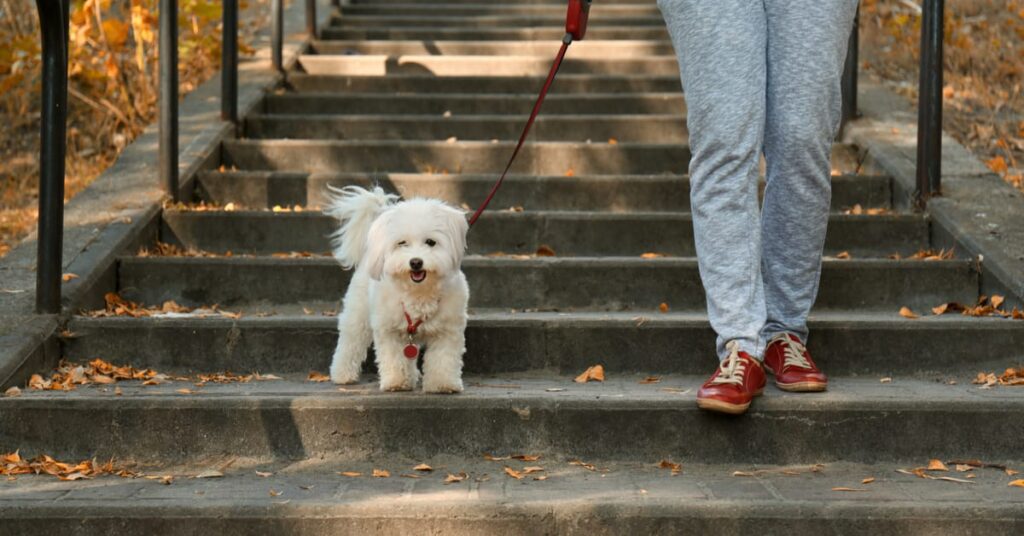
Sniff walks are called a variety of different terms including dog-led walking, decompression walks, scent walks, free walks, and sniffaris. The general idea is to provide your dog with the opportunity to take the lead over where they walk, to not be pulled along, and to get to sniff and explore as much as they want.
Not only is this fun for dogs, but it also can be a great way for dogs to burn off stress and decompress after stressful events like a visit to the vet or groomer, or from having holiday visitors in your home.
Giving Your Dog Control
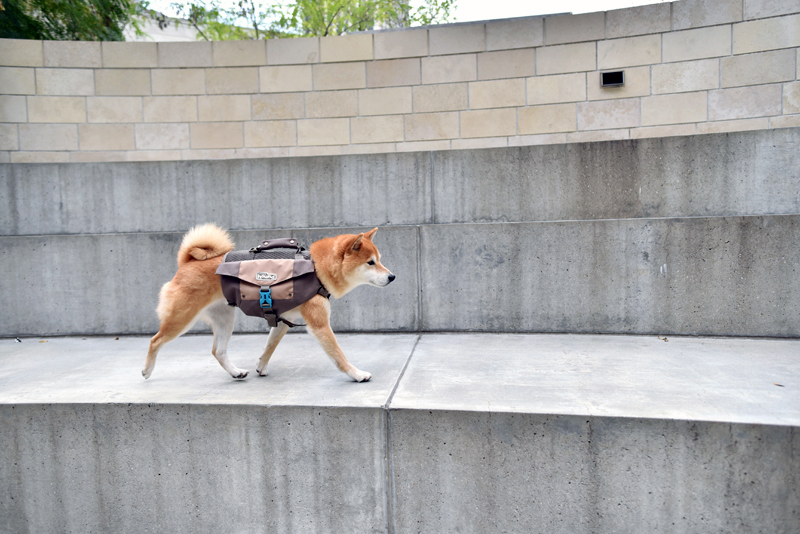
Dogs rely on us to keep them safe, entertained, and occupied during the day. As their guardians, we control and dictate a lot about what our dogs do during the day, what time they eat when they go out for walks, what toys they have, and when and if they have access to playing with or engaging with other dogs, or exciting things in the environment like water, mud, or underbrush. Dogs thrive on structure, routine, and clear expectations.
Dogs are very happy to let us take the lead, but it can be fun, and enriching when time and space allow, to give your dog the opportunity to take the lead and make decisions about where and when you walk.
The best way I know to tire out a dog out in a healthy way is not to get it physical exercise, but to give it mental exercise. Tricks are one way to do that, but letting a dog use its nose-brain connection is another.
Patricia McConell, PhD, CAAB Emeritus
These “free walks” give your dog an opportunity to just be a dog. The purpose of a free walk isn’t to work on training-specific skills like loose leash walking or heeling. Instead, the goal is for dogs to be able to sniff and explore anywhere and everywhere they want (so long as it’s safe) and to make all the decisions about where you walk and what you do. On a free walk, your dog takes the lead instead of being hurried along and asked to stop sniffing.
Supplies Needed for a Free Walk
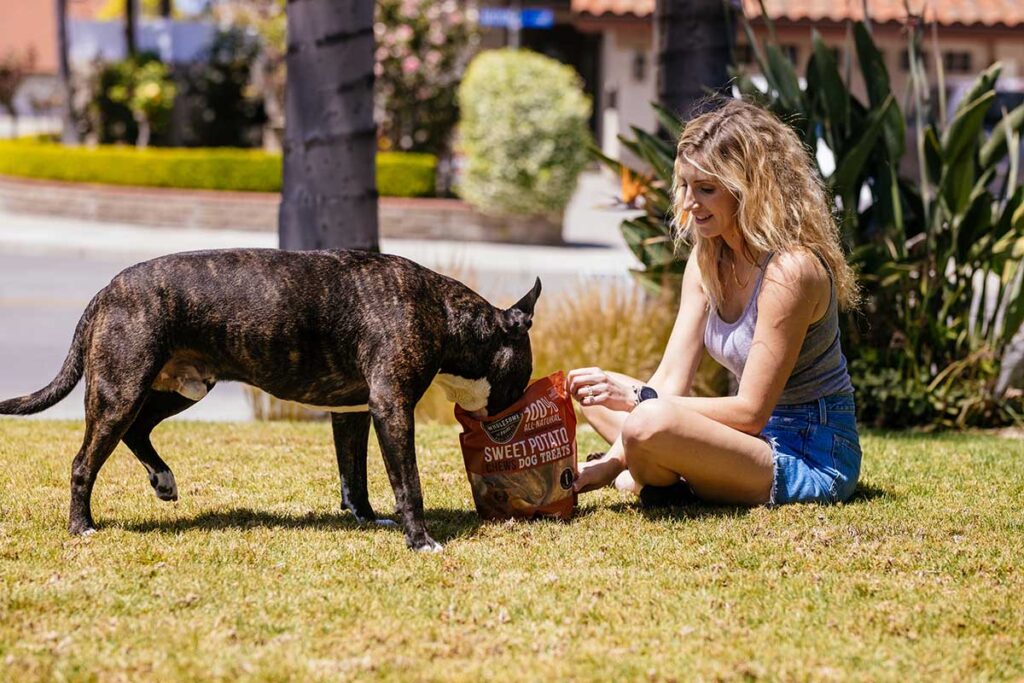
When taking your dog on a sniff walk it’s important to be prepared with your normal dog-walking supplies. If you’ll be in a quiet area, bring some extra supplies to give your dog a little more freedom. You’ll want to have packed:
- High-value treats in your pocket, your dog’s pack, or treat pouch so that you can reward your dog for being close and focused on you. This is helpful if you need to call your dog away from something that could cause them harm like a dead animal, garbage, or if you see a person or other dog and need to get your dog close to you.
- Comfortable harness: If you’re walking your dog in a busy city environment it may be best for you to walk your dog on a collar, front-clip harness, or head collar to help keep your dog safe and to prevent pulling. When you’re able to get your dog to a more open area to walk, it can be helpful to outfit your dog with a soft and comfortable back-clip harness that doesn’t restrict movement.
- Leash: You’ll want to have a 6-foot leash as you would have for any other walk. This is the leash you’ll use getting to a quieter area, or anytime you need to keep your dog closer to you on the walk.
- Long line leash: Long line leashes come in a variety of lengths from 10 feet to 30 feet. Long lines help allow your dog space to explore and wander while keeping them safely attached to you. If your dog is wearing a long line, make sure it’s connected to the back clip of a harness to prevent your dog from injuring their neck if they do hit the end of the line.
Safety First
While allowing your dog to take the lead on your walk it’s important to always keep safety in mind. Always follow leash laws, and don’t allow your dog to chase or harass wildlife. Regardless of how friendly your dog is, don’t allow your dog to approach people or other dogs. Your dog’s sniffing adventure shouldn’t interfere with anyone else’s safety, comfort, or enjoyment of the area.
Finding Safe Spaces for Scent Walks
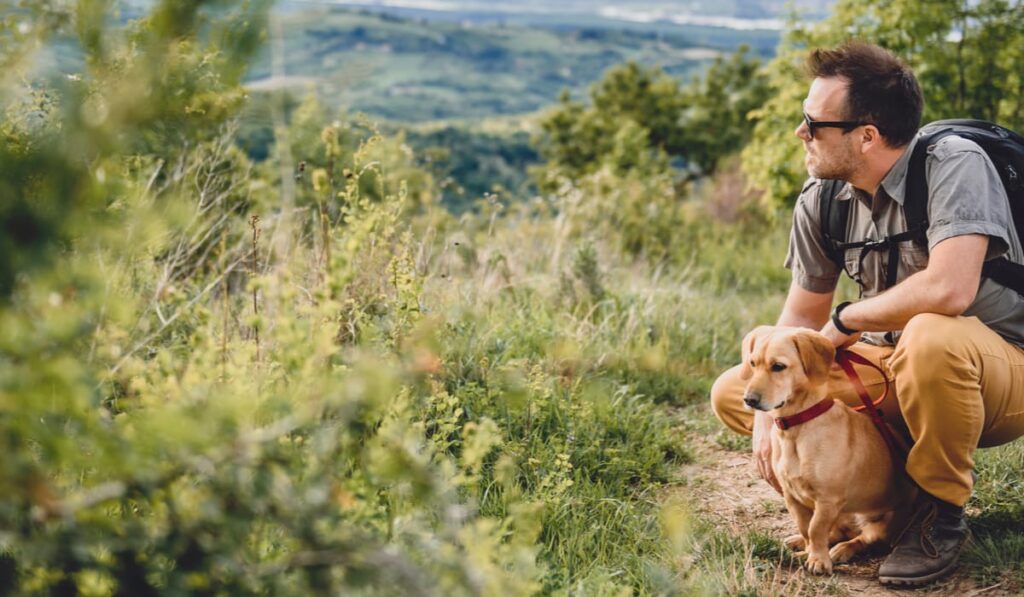
When letting your dog on a free or sniff walk, especially if you’re going to use a long line, it’s important to find a space that is safe, fun, and comfortable for your dog. For some dogs and their people, this will look like quiet hiking trails, or a beach if it’s possible to access. For others, it will be a park or deserted street at a quieter time during the day or night.
When I lived in NYC with a highly dog-reactive former street dog, I got very good at finding less popular areas of parks where I could give my dog opportunities to play and explore outside at her own pace with minimal risk of being bothered by other dogs or people.
If you live in a city and have an anxious or reactive dog, it can take a little while and some trial and error to find walking areas that are less populated. If you aren’t sure about an area, or if it’s more populated than expected it’s a good idea to put the long line away and keep your dog on a shorter leash and closer to you.
Feeling stuck about where to go with your dog? An online search for dog-friendly state or local parks and hikes can be a great way to discover new places to take your dog.
Looking for somewhere with guaranteed privacy for your nervous dog? Sniffspot is a national company that creates opportunities for property owners to rent out access to their fenced yards to dog owners. This can be a great opportunity to schedule private outings for reactive or anxious dogs, especially those who live in apartments and might not otherwise have opportunities to access safe and relaxing natural spaces that they can explore on a long line, or if the property is private and fully fenced, off-leash.
Creating Time for Dog-Led Walks
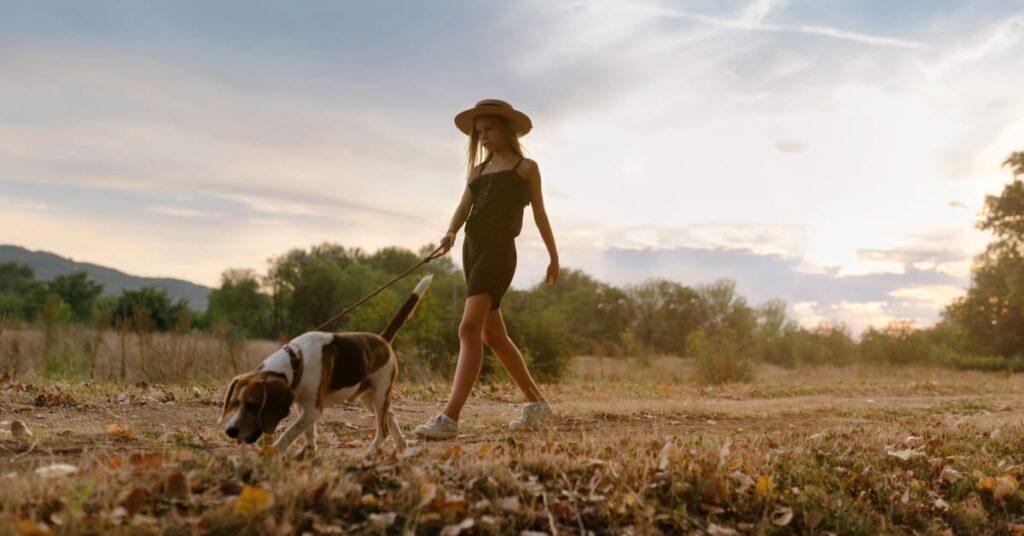
Whenever your schedule allows is a great opportunity to let your dog have some extra freedom and control over where they walk, and for how long you stay out. If you know your dog has been having a hard day, or a hard week it can be good to find the space and take some time to let your dog head out and sniff and explore. If you have a dog who is stressed by the vet, it can be fun to plan a stress-reducing free walk after their appointment. This can help your dog lower arousal and anxiety levels that have built up from a stressful situation.
Fitting in scent work on regular walks
Even if you don’t have time to take your dog somewhere spacious where you can clip on a long line and let your dog explore, you can let your dog have a mini-sniffari on your regular daily walk. To do this let your dog dictate the speed of the walk and allow your dog to sniff for as long as they want without being rushed.
We all have busy schedules and there are times when walking the dog needs to be focused on getting from one place to the next as quickly as possible. However, when you have the flexibility in your schedule to give your dog more freedom to explore, it’s an easy way to provide extra stress-relieving enrichment in your dog’s day.
While these dog-led walks in quiet natural spaces where dogs can safely be on a longer leash with more room to explore can be especially rewarding, it’s possible to apply the principles to a city walk and still see benefits.
Sniffing is about information gathering for our dogs, but it’s also stress-reducing. Providing your dog with opportunities to sniff and explore more can give your dog a more enriching life. In addition, quietly watching your dog as their nose takes the lead can be eye-opening and enriching for you as you notice the little things your dog pays attention to you previously would have walked past.
Physical & Mental Health Benefits of Scent Walks

All dogs regardless of age or breed can benefit from not just physical exercise, but mental exercise and enrichment as well. One of the best ways to help dog exercise their minds is to provide opportunities to sniff.
Patricia McConnell, Ph.D, Certified Applied Animal Behaviorist (CAAP), and author notes: “The best way I know to tire out a dog in a healthy way is not to get it physical exercise, but to give it mental exercise. Tricks are one way to do that, but letting a dog use its nose-brain connection is another.”
In particular, high-energy, high-anxiety dogs can really benefit from opportunities that go beyond stretching their legs. Exercising their minds is essential, too. Sniff walks are the best of both worlds. It’s an activity that provides our dogs with the physical exercise they need as well as mental stimulation and enrichment that can help increase your dog’s focus at home, when you’re training, and when you need to take more structured walks.

